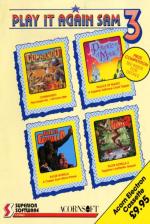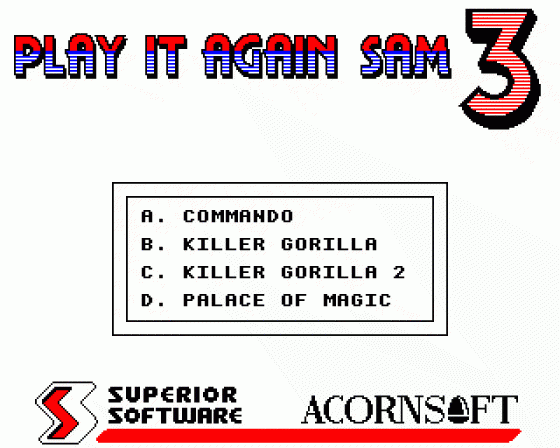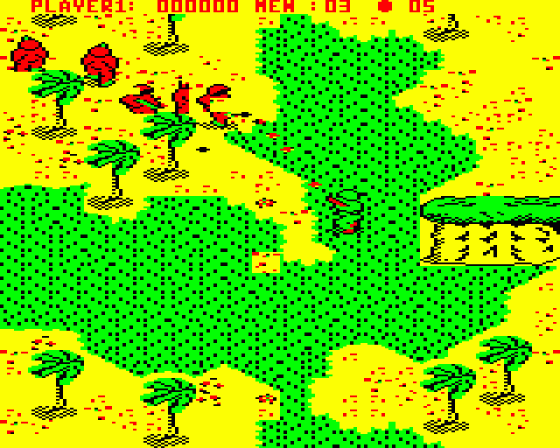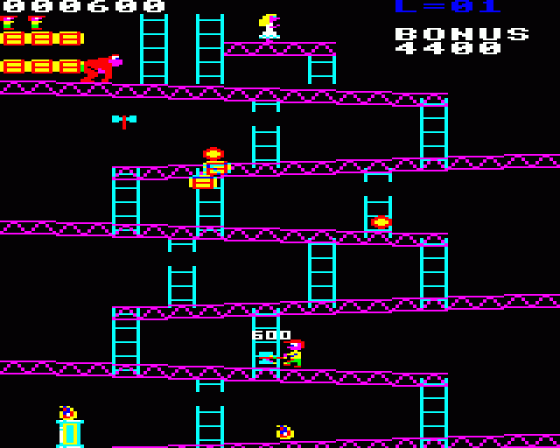
Electron User
 1st January 1989
1st January 1989
Categories: Review: Software
Author: Martin Reed
Publisher: Superior/Acornsoft
Machine: Acorn Electron
Published in Electron User 6.04
The Sam 3 compilation includes two games that did not originate in the Superior stable - Elite's Commando and Micro Power's Killer Gorilla. Commando is the officially licensed home computer version of the arcade machine of the same name. For the information of anyone who has not been in an amusement arcade in the last few years, or who missed the game on its initial release for the Electron, Commando is another of the one-man-against-the-odds combat games that have becomes so popular in recent years.
You are Super Joe, the commando of the title. Armed only with a submachine gun and half a dozen grenades, you must penetrate the enemy defences and destroy the fortress. Easy to describe, but of course, much less easy to do.
Commando features a number of different screens. Once you have fought your way from the bottom of one screen to the top it scrolls down to reveal new hazards. You thus get the impression of fighting one continuous battle.
Every new screen brings a fresh horde of enemy soldiers streaming from all quarters. Your machine gun makes short work of them, and your grenades come in handy when their numbers become too great, but remember that they are equipped with similar weapons. One stray bullet or grenade can prove fatal, so keep a sharp eye about you.
This re-released Commando incorporates one key improvement. When playing the original game you sometimes could not determine from the screen display when you have been killed. Now there is no doubt. A blinding white flash heralds your call-up to the ranks of the ex-commandos.
I have never been particularly impressed by Commando. Its main drawback is that it comes off very badly from the dilemma that faces every programmer - weighing up the pros and cons of each screen mode and the conflicting features of screen resolution, screen size and available colours.
Commando runs in Mode 5 which allows only four colours on screen at any one time. I found that many graphic features tended to merge into one another. Nevertheless, if you're a fan of shoot anything that moves' games you could do worse than pick this one.
Killer Gorilla will need little introduction to the majority of Electron owners. It is an excellent implementation of the ever-popular arcade machine game Donkey Kong. Although it was released in the relatively early days of the Electron, I have never seen another version that surpasses it in quality and playability. When an officially licensed version did the rounds of the popular home computers a few years ago I was interested to see that no Electron version ever appeared - Killer Gorilla got it right first time.
The game was inspired by the 1933 film King Kong. You play the part of Mario, a humble carpenter whose girlfriend the evil Kong has carried off the top of an unsteady tower of scaffolding. You have to climb it to rescue her.
You scale each section of scaffolding, avoiding the barrels that Kong throws in an attempt to dislodge you. Unfortunately, these barrels are by no means your only problems - fireballs and custard pies also threaten to send you to a sticky end.
However, help is at hand. Large hammers hang above your head at intervals. Jump up and grab one and you can destroy any moving hazard that comes within reach. However, their effectiveness quickly wears off, often at fatally inconvenient moments. Moreover, Kong will not willingly surrender your lady; just as you catch up with him at the top of one section he whisks her up to the next.
The game features four screens, each more difficult than the last. The first is a straight climb from the bottom to the top of the screen, the second introduces conveyer belts that keep changing direction. The third features lifts made of pieces of girder, and bouncing girders that can quickly cut down an inattentive carpenter.
The fourth and last screen looks perfectly straightforward, but is rapidly overrun with deadly fireballs. However, the screen also includes two hammers, and if you can reach them in time they will make short work of your fiery adversaries.
After you have completed this level and defeated the gorilla, you return to the first screen to find that things have changed, for the worse. The first screen now features gaps in the framework of girders - and you have to jump for your life. The conveyers on screen two move more quickly than before, as do the lifts on screen three. In all, the game has fifteen increasing difficult levels, enough to test even the most ardent hero. Killer Gorilla is a classic game that still provides hours of amusement.
Just as Killer Gorilla is an implementation of the arcade machine game Donkey Kong, Killer Gorilla 2 is a version of the arcade follow-up Donkey Kong Junior. Older players may remember the game's original release, under the name of Zany Kong Junior. Unfortunately, that release had to be withdrawn for copyright reasons - I suspect that it was too good a copy of the arcade original.
In Killer Gorilla 2 the roles have been reversed. Mario - now called Morris - has defeated Kong and rescued his girlfriend; however, in an act of revenge he has captured Kong. You, Kong Junior, must rescue your elder.
As in Killer Gorilla Mark 1, you must make your way from the bottom to the top of successive screens, but there the similarity ends. You start off in the jungle, and manoeuvre yourself around a network of platforms, vines and creepers, to the top of the screen where your caged parent sits helplessly. However, no sooner do you reach the brutal Morris and the cage that they are gone. The chase is on.
Like its predecessor, Killer Gorilla 2 features four different screens that repeat with increased difficulty. Unlike the original, the four screens don't follow a consistent theme. The first requires you to swing around a network of vines bridged by brick platforms.
Unfortunately, as usual, the screen is far from deserted. You soon discover that a number of disembodied snapping heads are travelling up and down the vines at great speed and doing their best to find out what baby gorilla tastes like. A single bite is fatal.
Pieces of fruit hand from the vines at regular intervals. You can buy time for yourself and your cause by dislodging them at opportune moments and crushing any hapless creature that may be underneath.
The second screen is totally different: the only way to reach the trailing chains way out of reach above your head is to bounce on a spring just in front of you. That obstacle cleared, you must now contend with a stream of giant parrots that home in on you relentlessly. Luckily there are a couple of usefully placed pieces of fruit to hand.
The third screen depicts the generator room where you scramble along electrical cables, avoiding the high voltage sparks that race around the circuit. This screen can be very difficult for so many sparks are speeding in different directions that even a small gorilla cannot evade them for long.
When you reach the fourth screen you long up to see Kong Senior's cage sitting on a girder high above your head where it is held in place by six ropes locked to the girder. The six keys are attached to chains hanging from the girder. Collect all six to release your parent.
You must now contend with both the snapping heads from the first screen and the giant parrots from screen two. As in the first Killer Gorilla game, once you have completed this screen, you are returned to a more difficult screen one to perform your feats of heroism all over again.
I found Killer Gorilla 2 much more difficult that its namesake, but it certainly adds a bit of variety to a well-established formula.
The last title in the collection is Palace Of Magic, an arcade adventure with more than 100 screens; it is very similar in appearance to Superior Software's classic Citadel. Palace Of Magic does not attempt to disguise the source of its inspiration - quite the reverse in fact. The plot of the game is that you have offended the evil wizard Caldeti - try rearranging the letters and see what comes out - who has shrunk you to the size of a dwarf and imprisoned you in the Palace of Magic. Your escape will not be easy.
As in Citadel, you have but one life and only a limited amount of energy. This is depleted whenever you spend too long under water or when you come into contact with any flames or any of the Palace's animated inhabitants. You can, however, replenish your energy by collection magical top hats dotted around and about.
I have heard that the more awkwardly-placed hats give greater rewards but this may be nothing more than a rumour. One point worth noting is that your energy level cannot be increased beyond its initial level. Do not pick up a top hat until you really need it, or you will waste some its magic.
Like Citadel, Palace Of Magic features a number of adventure-style puzzles to be solved in the correct order before you can get into some of the more remote areas of the Palace and surrounding landscape.
For example, you may find that your path is blocked by a blue and cyan door . Before you can progress any further you will need to find a blue and cyan key. Of course, you may need to solve other puzzles before you can get to the key. What must you give to the vicar before he will let you into the chapel? Who can you bribe with the gold bar? It is essential to plan ahead. As with any adventure, drawing a map will help.
If you like games that require a combination of logical thought and manual dexterity, Palace Of Magic will provide a considerable test of both skills.
* * * Second Opinion (By Janice Murray) * * *The Sam series of compilations are simply superb value for money. The games were rated very highly when originally released and the quality is top notch. They provide endless hours of enjoyment for all the family.
The only problem with it (and this goes for all compilations) is that you may already have one or more of the games. However, even if you have two originals, the other two games still work out at under a fiver each which can't be bad.
Other Reviews Of Play It Again Sam 3 For The Acorn Electron
Play It Again Sam 3 (Superior/Acornsoft)
A review by Dave Reeder (A&B Computing)
Play It Again Sam 3 (Superior/Acornsoft)
A review by Mark Elmer (Acorn User)
Other Acorn Electron Game Reviews By Martin Reed
Scores
Acorn Electron Version| Sound | 9 |
| Graphics | 9 |
| Playability | 9 |
| Value For Money | 9 |
| Overall | 9 |
| Award | Electron User Golden Game |
















